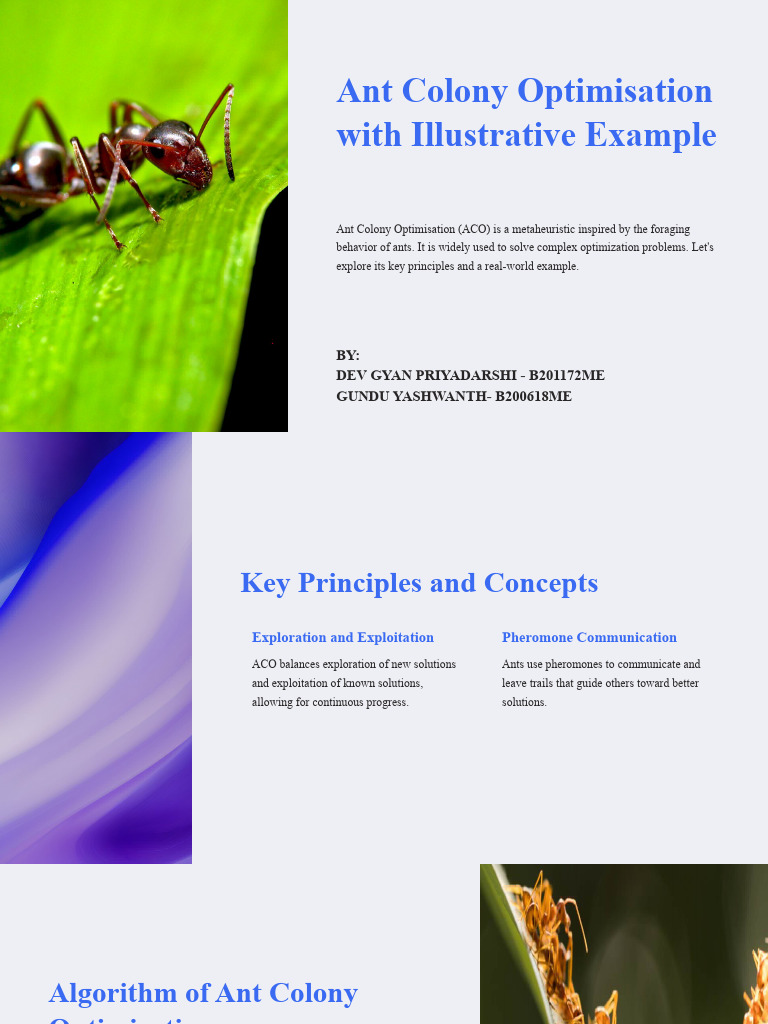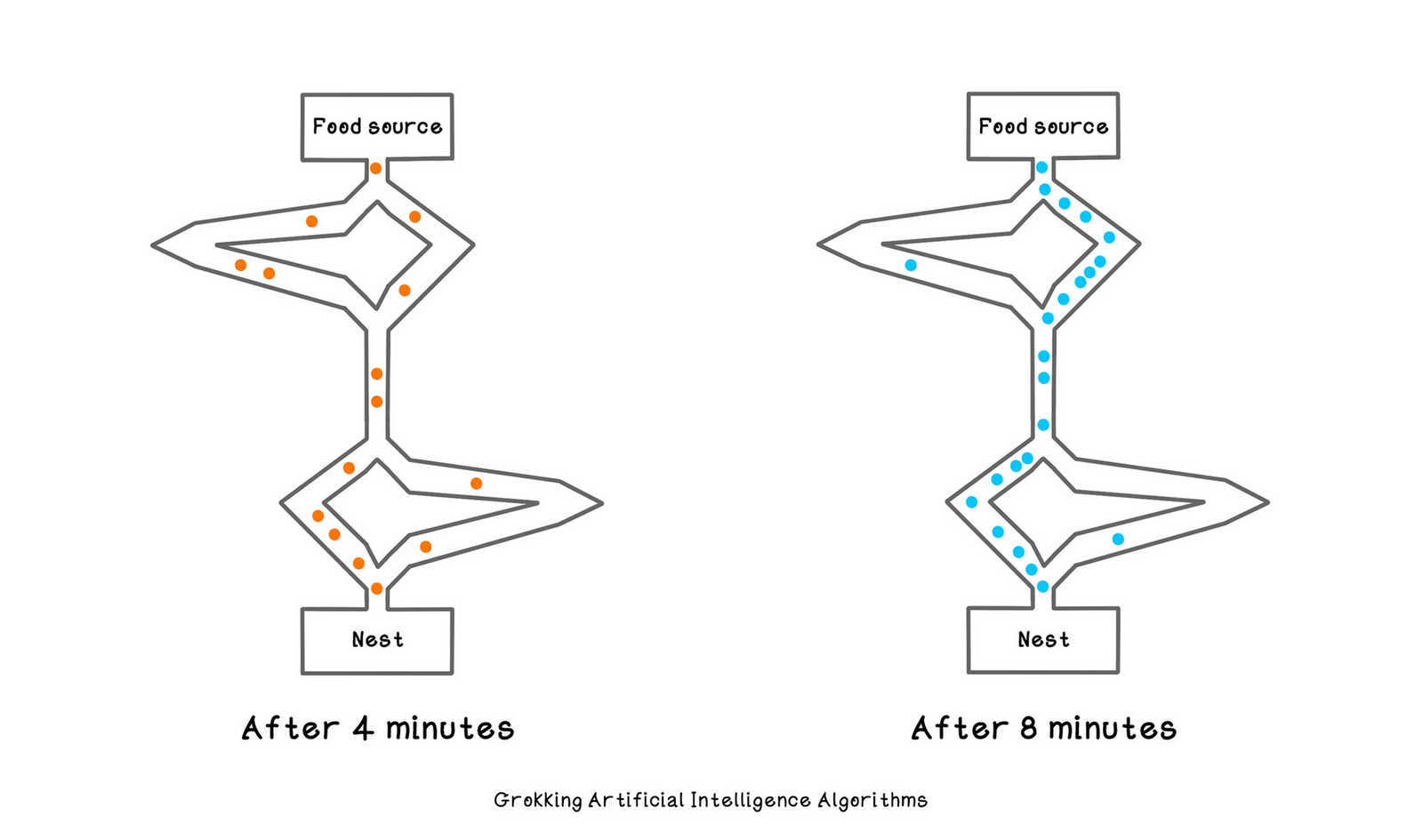Ant Colony Optimisation

Ant Colony Optimization (ACO) is a fascinating metaheuristic algorithm inspired by the natural behavior of ants in finding optimal paths to food sources. This nature-inspired algorithm has revolutionized various fields, including optimization, machine learning, and artificial intelligence. By mimicking the collective intelligence of ant colonies, ACO offers efficient solutions to complex problems, making it a popular choice among researchers and developers.
The Intriguing World of Ant Colony Optimization

Ant Colony Optimization algorithms have gained prominence due to their ability to tackle intricate optimization problems, often finding near-optimal solutions. The fundamental concept revolves around simulating the behavior of real ants, who use pheromone trails to communicate and collaborate, ultimately leading them to the most efficient paths.
In the context of ACO, artificial ants are deployed to explore the solution space, leaving digital pheromone traces. These pheromone trails, much like in nature, guide other ants towards promising solutions. Over time, the ants reinforce the most successful paths, gradually converging towards the optimal solution.
Key Principles of Ant Colony Optimization
- Pheromone Trails: Artificial ants deposit and update pheromone trails based on the quality of the solutions they discover. Higher-quality solutions attract more pheromone deposits, making them more attractive to other ants.
- Ant Colony Convergence: As ants explore and reinforce the best paths, the algorithm converges towards the optimal solution. This convergence is a crucial aspect of ACO’s effectiveness.
- Local Search: ACO often incorporates local search techniques to refine the solutions found by the ants, ensuring a thorough exploration of the search space.
Applications of Ant Colony Optimization
The versatility of ACO algorithms makes them applicable across diverse domains. Some notable use cases include:
- Routing and Logistics: ACO is particularly effective in optimizing vehicle routing, delivery schedules, and transportation networks, leading to significant cost savings and improved efficiency.
- Network Design: In network optimization, ACO can design efficient network topologies, allocate resources, and manage congestion, ensuring robust and scalable networks.
- Traveling Salesman Problem (TSP): A classic optimization problem, TSP finds optimal routes for a salesman to visit multiple cities once. ACO provides effective solutions, especially in large-scale TSP instances.
- Machine Learning: ACO is utilized in various machine learning tasks, such as feature selection, clustering, and neural network training, enhancing the performance and efficiency of ML models.
ACO vs. Other Metaheuristics
While there are several metaheuristic algorithms available, such as Genetic Algorithms (GA) and Particle Swarm Optimization (PSO), ACO offers unique advantages. Some key differences include:
| Aspect | Ant Colony Optimization (ACO) | Genetic Algorithms (GA) | Particle Swarm Optimization (PSO) |
|---|---|---|---|
| Inspiration | Behavior of real ants | Natural selection and genetics | Social behavior of bird flocks or fish schools |
| Solution Representation | Ants as agents | Chromosomes | Particles |
| Exploration vs. Exploitation | Balances exploration and exploitation through pheromone trails | Genetic operators favor exploitation | Tends to favor exploitation |
| Convergence Speed | Generally slower but can find high-quality solutions | Often faster but may converge to local optima | Fast convergence but may miss global optima |

Each metaheuristic has its strengths and weaknesses, and the choice depends on the specific problem and requirements. ACO's ability to balance exploration and exploitation makes it a reliable choice for complex optimization tasks.
Implementing Ant Colony Optimization: A Step-by-Step Guide

Implementing an Ant Colony Optimization algorithm involves several key steps. Here’s a detailed guide to help you develop your own ACO algorithm:
Step 1: Problem Definition and Objective Function
Start by clearly defining the problem you aim to solve. Identify the decision variables, constraints, and the objective function you want to optimize. The objective function represents the quality of a solution and guides the ants towards better solutions.
Step 2: Initialize the Ant Colony
Create a population of artificial ants. Each ant represents a potential solution to the problem. Initialize the ants’ positions and define their movement rules. You can also assign initial pheromone values to the ants based on the problem’s characteristics.
Step 3: Define Pheromone Update Rules
Establish the rules for updating pheromone trails. This is a critical step as it determines how ants reinforce good solutions. The pheromone update rules should reflect the quality of the solutions found by the ants. Common strategies include increasing pheromone values for high-quality solutions and decreasing values for less promising ones.
Step 4: Ant Movement and Solution Construction
Define the movement rules for the ants. Each ant should explore the solution space and construct a solution based on the pheromone trails and other problem-specific heuristics. The movement rules determine how ants select the next node or decision variable to visit.
Step 5: Local Search and Solution Refinement
Implement a local search technique to refine the solutions found by the ants. Local search helps improve the quality of the solutions by exploring nearby regions of the search space. This step is crucial for ACO’s effectiveness, as it can lead to better solutions.
Step 6: Pheromone Evaporation
Introduce pheromone evaporation to prevent the algorithm from getting stuck in local optima. Evaporation reduces the pheromone values over time, encouraging ants to explore new paths and avoid converging prematurely.
Step 7: Iterate and Optimize
Repeat steps 3 to 6 for a predefined number of iterations or until a stopping criterion is met. As the algorithm progresses, the ants should converge towards better solutions, and the pheromone trails should guide them towards the optimal solution.
Step 8: Post-Processing and Analysis
After the algorithm has converged, analyze the results. Compare the final solutions with the known optimal solution (if available) or with other benchmark solutions. Perform sensitivity analysis to understand the algorithm’s behavior under different parameter settings.
Step 9: Fine-Tuning and Optimization
Based on the analysis, fine-tune the ACO algorithm’s parameters to improve its performance. This step involves experimenting with different pheromone update rules, evaporation rates, and local search strategies to achieve the best results for your specific problem.
Real-World Examples of ACO Implementation
Ant Colony Optimization has been successfully applied to various real-world problems. Here are a few examples:
- Traffic Light Control: ACO has been used to optimize traffic light timings, reducing congestion and improving traffic flow in urban areas.
- Vehicle Routing: ACO algorithms are employed to optimize vehicle routes, considering factors like distance, time, and customer demands, resulting in cost-effective delivery systems.
- Job Shop Scheduling: In manufacturing, ACO helps optimize job shop scheduling, minimizing production time and maximizing efficiency.
- Image Segmentation: ACO has been applied to image processing tasks, particularly in segmenting images into meaningful regions, aiding in object recognition and image analysis.
Challenges and Future Prospects of Ant Colony Optimization
While ACO has proven to be a powerful optimization tool, it also faces certain challenges. Some of the key challenges include:
- Parameter Tuning: ACO's performance is highly dependent on the choice of parameters, such as pheromone update rules and evaporation rates. Finding the optimal parameter settings can be challenging and requires careful experimentation.
- Scalability: ACO's effectiveness may diminish with an increasing number of decision variables or problem complexity. Developing scalable ACO algorithms remains an active area of research.
- Convergence Speed: ACO's convergence speed can be slower compared to other metaheuristics, especially for large-scale problems. Researchers are exploring ways to improve ACO's convergence speed without compromising solution quality.
Despite these challenges, the future of Ant Colony Optimization looks promising. Researchers are continually working to enhance its performance, scalability, and applicability to a wider range of problems. The integration of ACO with other optimization techniques and the development of hybrid algorithms are exciting avenues for future research.
Frequently Asked Questions (FAQ)
How does ACO handle multi-objective optimization problems?
+ACO can be extended to handle multi-objective optimization by incorporating multiple objective functions and defining a preference or trade-off between them. This allows ACO to find a set of non-dominated solutions, known as the Pareto front, representing the best trade-offs between the objectives.
Can ACO be used for continuous optimization problems?
+Yes, ACO can be adapted for continuous optimization problems by discretizing the continuous space or by using continuous pheromone values. Several variants of ACO, such as Continuous Ant Colony Optimization (CACO), have been developed specifically for continuous optimization tasks.
What are some common variations of ACO algorithms?
+Some common variations of ACO include Max-Min Ant System (MMAS), Ant Colony System (ACS), and Ant Colony Optimization with Elitist Learning (ACO-EL). These variations differ in their pheromone update rules, local search strategies, and other algorithmic components.
How does ACO compare to other swarm intelligence algorithms like PSO or GA?
+ACO, PSO, and GA are all metaheuristic algorithms inspired by different natural phenomena. ACO is inspired by ant behavior, PSO by bird flocks, and GA by natural selection. Each algorithm has its strengths and weaknesses, and the choice depends on the problem’s characteristics. ACO often excels at balancing exploration and exploitation, making it suitable for complex optimization tasks.
What are the key advantages of using ACO over traditional optimization methods?
+ACO offers several advantages over traditional optimization methods. It can handle complex, nonlinear, and combinatorial optimization problems effectively. ACO’s ability to balance exploration and exploitation allows it to find near-optimal solutions, even in large and complex search spaces. Additionally, ACO’s decentralized nature and collective decision-making make it robust and scalable.



